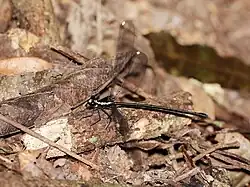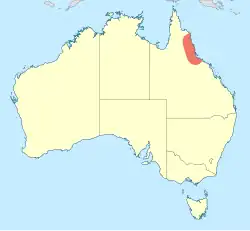Podopteryx selysi
| Treehole flatwing | |
|---|---|

| |
| Female, north Queensland | |
| Scientific classification | |
| Kingdom: | Animalia |
| Phylum: | Arthropoda |
| Class: | Insecta |
| Order: | Odonata |
| Suborder: | Zygoptera |
| Family: | Argiolestidae |
| Genus: | Podopteryx |
| Species: | P. selysi
|
| Binomial name | |
| Podopteryx selysi | |

| |
Podopteryx selysi is a species of Australian damselfly in the family Argiolestidae,[3] commonly known as a treehole flatwing.[4] It can be found in coastal northern Australia and New Guinea, where its larvae live in water-filled holes in tree trunks in rainforest.[5]
Podopteryx selysi is a very large damselfly, black-metallic in colour with white to pink markings on its head and body.[4] Like other members of the family Argiolestidae, it rests with its wings outspread.[6]
Unusually, and possibly uniquely for a damselfly, the hindwings of Podopteryx selysi are longer than its forewings. For other damselflies, forewings are usually marginally longer than hindwings.
Gallery
-
.jpg) Tip of female tail. Note the egg still in her ovipositor.
Tip of female tail. Note the egg still in her ovipositor. -
.jpg) Tip of male tail
Tip of male tail -
.jpg) Female wings
Female wings -
.jpg) Male wings
Male wings -
.jpg) Australian Museum specimen
Australian Museum specimen
See also
References
Wikimedia Commons has media related to Podopteryx selysi.
- ^ Dow, R.A. (2020) [amended version of 2017 assessment]. "Podopteryx selysi". IUCN Red List of Threatened Species. 2020: e.T87532918A176958418. doi:10.2305/IUCN.UK.2020-3.RLTS.T87532918A176958418.en. Retrieved 20 November 2021.
- ^ Förster, G. (1899). "Contributions à la faune odonatologique Indo-Australe". Annales de la Société Entomologique de Belgique (Comptes-rendus) (in French). 43: 63–72 [70].
- ^ "Species Podopteryx selysi (Förster, 1899)". Australian Faunal Directory. Australian Biological Resources Study. 2012. Retrieved 14 April 2017.
- ^ a b Theischinger, Günther; Hawking, John (2006). The Complete Field Guide to Dragonflies of Australia. Collingwood, Victoria, Australia: CSIRO Publishing. p. 58. ISBN 978-0-64309-073-6.
- ^ Theischinger, Gunther; Endersby, Ian (2009). Identification Guide to the Australian Odonata (PDF). Department of Environment, Climate Change and Water NSW. p. 233. ISBN 978-1-74232-475-3.
- ^ Watson, J.A.L.; Theischinger, G.; Abbey, H.M. (1991). The Australian Dragonflies: A Guide to the Identification, Distributions and Habitats of Australian Odonata. Melbourne: CSIRO. ISBN 0643051368.
